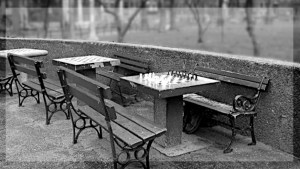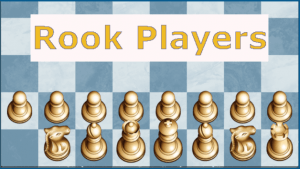
Professor of Chess
Jacob Henry Sarratt
(1772-1819)
Jacob Henry Sarratt, born in 1772, worked primarily as schoolmaster but was much better known for his avocations which, of course, included chess.
After Philidor's death, Verdoni (along with Leger, Carlier and Bernard - all four who co-authored "Traité Théorique et Pratique du jeu des Echecs par une Societé d' Amateurs") was considered one of the strongest players in the world, especially in England.
Verdoni had taken Philidor's place as house professional at Parsloe's coffeehouse. He mentored Jacob Sarratt until he died in his apartment on Panton St., London, in 1804. That year Sarratt became the house professional at the Salopian at Charing Cross in London.
Sarratt claimed the title of "Professor of Chess," as Verdoni had before him, while teaching chess at the price of a guinea per game. By today's measure Sarratt was not a particularly strong player but he was considered the strongest player of his time (His student, William Lewis, actualy claimed Surratt was stronger than Labourdonnais). It's been said by some that he maintained the illusion of strength by avoiding the stronger players as he lorded over his students who didn't know better. Still, for those chess players exposed predominantly to the style of play based on Ruy Lopez and refined by Philidor, the revival of the Modense School, based more on the Romantic ideas of Greco, the attacking, combinative style of Sarratt must have seemed like a breath of fresh air.
Surratt had a notion that chess culminated in the 16th century and that everything since then had been a step backwards. This peculiar notion had a positive side. Philidor was the darling of the English chess scene. Almost all books at that time were versions of, or at least based upon, Philidor's "Analyse." Surratt at least kept open the possiblitly that there were ideas beyond (and before) those of Philidor.
In 1818 Johann Mälzel, the owner of the Turk at that time, tried to hire Sarratt to serve as one of its operators (called directors) in England (Jacques François Mouret was the current director). Sarratt, too sick at the time to consider it, recommended one of his students, William Lewis. While serving in that capacity, Lewis in turn recommended fellow student, Peter Unger Williams, who also became a director of the Turk.
Lewis, Sarratt's pupil wrote about his mentor:
A long and intimate acquaintance with Mr. Sarratt, during which he frequently had the pleasure of playing with him, and of seeing him play, enables the Editor to assert, without hesitation, that he was the finest and most finished player he has ever seen, alike excellent in attack and defense, and capable of unravelling intricate positions with ease and accuracy. Those who form their opinion of Mr. Sarratt’s skill from his publications only, will not rank him so high as he deserved, for Mr. S. was, unfortunately, too regardless of his fame to pay that attention to his Works which the reader has a right to expect. The pecuniary difficulties in which he was unfortunately involved, compelled him to write rapidly, and made him gladly prefer copying games from other books to giving new ones, which would have required a careful and laborious examination.
Sarratt's most important contribution to chess was that he mentored William Lewis who in turn mentored Alexander McDonnell (of La Bourdonnais vs. M'Donnell fame).
In 1808, true to his role as a teacher, Surratt published his "Treatise on the Game of Chess," a book, mainly confined to direct attacks on the king but his book systematically studied openings, first from the attacker's perspective and secondly by that of the defender; he also offered 75 endgames. He translated several older writers whom he admired (though his translations are not considered particularly good - Sarratt's translation of Damiano, Lopez, and Salvio and that of Gianutio and Selenus, as Willard Fise put it are "so mutilated as to be of little value," and such that Geo. Walker call them his "his barbarously mutilated translations."):
"The Works of Damiano, Ruy Lopez and Salvio" in 1813.
"The Works of Gianutio and Gustavus Selenus" in 1817.
In 1821 a posthumous edition of his Treatise, "A New Treatise on the Game of Chess," primarily a work of William Lewis wasa marked improvement over the original. It was published by William Lewis under Sarratt's name. This copy covered the game of chess as a whole and was designed for the novice player. It also contained a 98 page analysis of the Muzio.
In addition to his chess books, Surratt also published:
"History of Man" in 1802,
"A New Picture of London" in 1803
He translated "Three Monks!!!" from French in 1803
and "Koenigsmark the Robber" from German in 1803.

Hooper and Whyld's "Oxford Companion to Chess" tells us that JH Sarratt served as a member of the Royal York Marle-bone volunteers during the Naopleaonic Wars and in 1803 wrote the following book:

Lieut. Sarratt, a French Huguenot who moved to England from Beaurais, France in 1779 and also named Jacob is said to have died during the Battle of Corunna in 1809. Since Jacob Sarratt the chess player lived 5 years after the war, it seems unlikely he is the same person who penned the diatribe against Napoleon. Compounding the confusion, Lieut. Sarratt had a son named Henry who also died during the war. (see Here).
His second wife, Elizabeth Camilla Dufour, was also a writer. In 1803 (before they were married, which was 1804), she published a novel called "Aurora or The Mysterious Beauty" (which was also lifted from a French book, "Aurora, ou l’amant mystérieuse" by J.J.M. Duperche). They met through their common publisher and were married the following year. Camilla Dufour was also a professional singer, though said to be somewhat second-rate. Her singing career began on Feb. 11, 1796 at King's Theatre; that year she sang at the Pantheon and at Hanover Square. In 1797 she signed a lucrative contract at Drury Lane where she sang soprano as Adele in 'The Haunted Tower.' In 1798, she was soloist in the Convent Garden Lent oratorios while also singing at Drury Lane. Too short and plump for leading roles, she retired from professional singing in 1799 and turned to writing. It was through their common publisher that she and Surratt met and soon married (at St Leonard, Shoreditch, on Dec. 30 1804). In 1809 she briefly took up singing again, appearing at the Royal Circus. His first wife, Marie Bruzard, whom he married in 1790 when both were 18 and with whom he had four children (Mary Ann Louisa, born Dec. 11, 1799 and Susan Catherine, born on 1 Feb. 1 1802, Henry and George) had died in 1802. Both his wives were from Jersey.
Contrary to what one might expect, Sarratt has been described as tall, lean and muscular and had even been a bare-knuckle prize-fighter at one point. He had also bred dogs for fighting. He was regarded as a very affable fellow and very well-read with a powerful memory but with limited taste.
William Hazlitt, who came to know Sarratt in the chess player's later life, wrote in his essay "On Coffee-House Politicians":
"[Dr. Whittle] was once sitting where Sarratt was playing a game
at chess without seeing the board... Sarratt, who was a man of
various accomplishments, afterwards bared his arm to convince
us of his muscular strength...
Sarratt, the chess-player, was an extraordinary man. He had the
same tenacious, epileptic faculty in other things that he had at
chess, and could no more get any other ideas out of his mind than
he could those of the figures on the board. He was a great reader,
but had not the least taste. Indeed the violence of his memory
tyrannised over and destroyed all power of selection.
He could repeat [all] Ossian by heart, without knowing the best
passage from the worst; and did not perceive he was tiring you
to death by giving an account of the breed, education, and
manners of fighting-dogs for hours together. The sense of reality
quite superseded the distinction between the pleasurable and
the painful. He was altogether a mechanical philosopher."
Sarratt died in 1819 after a protracted illness during which he couldn't work, leaving his wife destitute. His posthumous book brought in some income, but his wife moved to Paris, supporting herself by giving chess instruction to the wealthy and aristocatic. In 1843 a subscription was raised for her financial support. Many chess amateurs contributed to the fund, as did "Le Palamède" (the chess magazine) and even King Louis-Philippe. Camilla died in 1846.
George Walker in "Chess & Chess-Players: Consisting of Original Stories and Sketches," mentions Sarratt in reference to blindfold play and gives this anecdote:
[Carrera] informs us in general terms, that the Turks in Hungary were accustomed to play chess together by memory while riding on horseback. This reminds me of our English chess professor, Sarratt, and the celebrated young French player, Hypolite de Bourblanc, who were accustomed, in the beginning of the present century, to play chess almost daily together in this manner, while strolling in the pleasant meadows then skirting the north of London. Upon these occasions, if the positions became too entangled for satisfactory solution on the spot, the game was'adjourned, until their return home afforded them the assistance of a chessboard. M. de Bourblanc could hardly find his equal here, except in the person of Mr. Sarratt, the first English player of his day; and would have probably struck a blow at the supremacy of Deschapelles himself, had fate spared his life a few more years. De Bourblanc was unfortunately drowned at sea, on a voyage to the Mauritius.
In his 1808 "Treatise," Sarratt enumerated a set of rules or laws of chess that served as the main reference during the first half of the 19th century (these are the rules first used by the London Chess Club that met at Tom's Coffeehouse in Cornhill where Sarratt usually played at that time). Among those rules, Sarratt established the Stalemate as a draw (as it was in 16th century Italy). The standard rule in England and many other countries at that time had been that the side giving Stalemate lost. As a proponent of the game as played in Italy, Sarratt greatly favored free-castling. Additionally, he was instumental in naming the opening now called the Sicilian by pointing out that it was first demonstrated by Carerra, a Sicilian.
A few Sarratt games:

